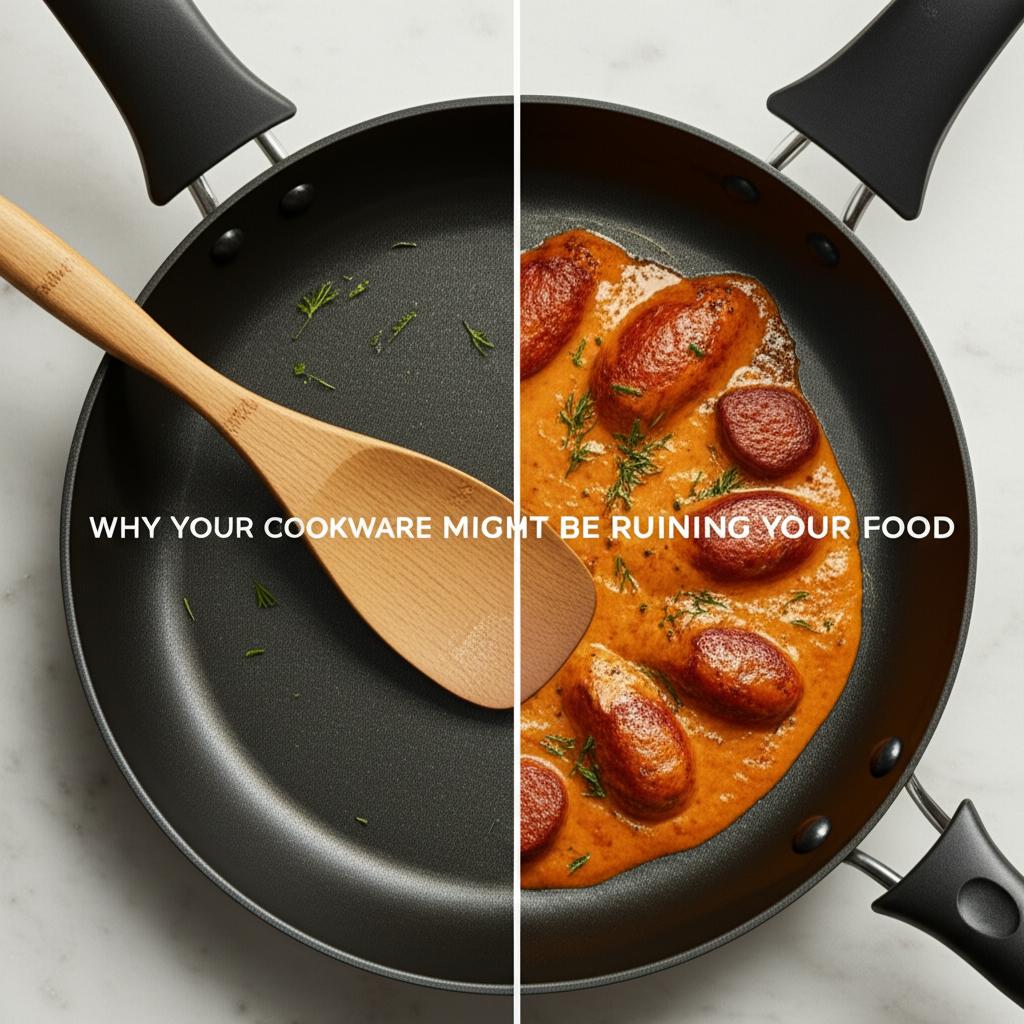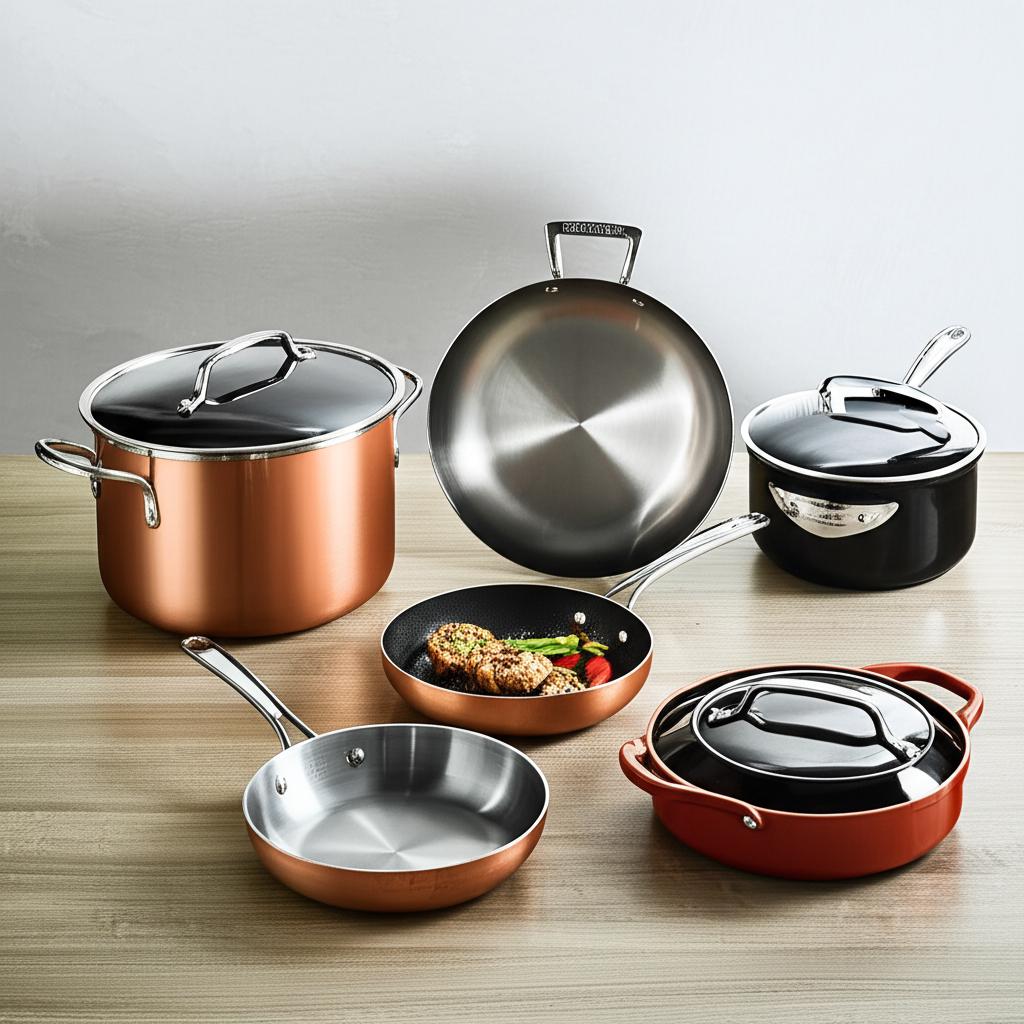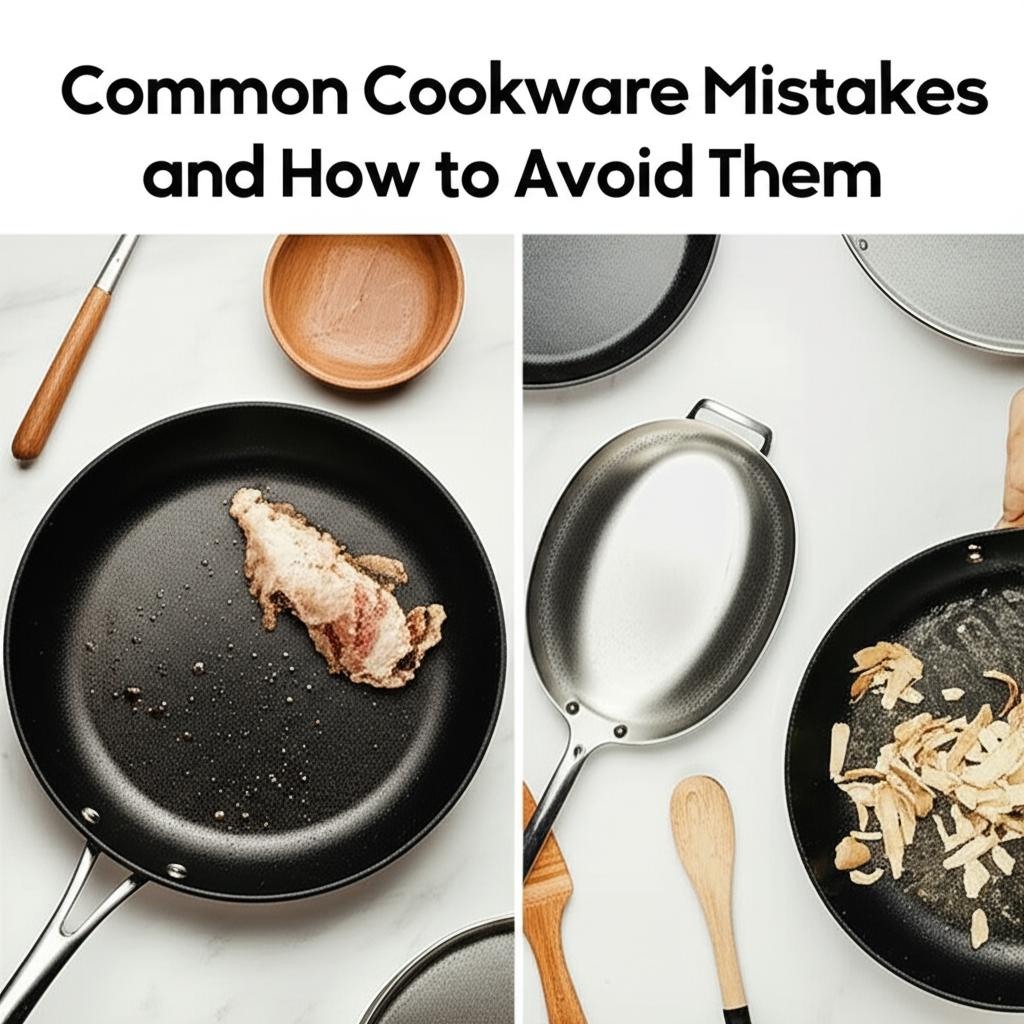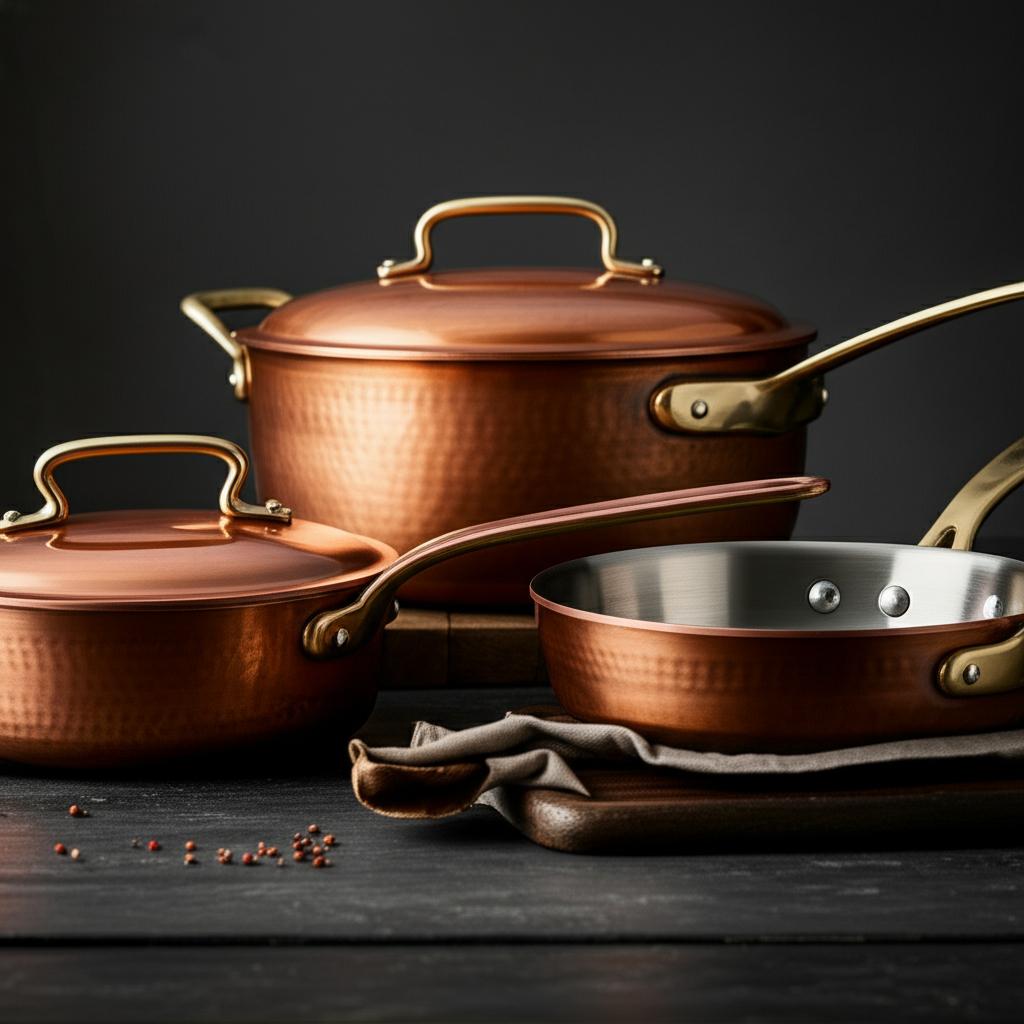
Is Your Cookware Ruining Your Food? The Surprising Truth & How to Fix It!
- CAROTE Pots and Pans Set Non Stick, Cookware Set Detachable Handle, Nonstick Induction Kitchen Sets Non Stick with Removable Handle, RV Cook Ware, Oven Safe, Black
- Caraway Mini Cookware Set – Non-Stick Ceramic Fry Pan (1.05 qt, 8″) Sauce Pan (1.75 qt) & Storage Rack – Non Toxic, PTFE & PFOA Free – Oven Safe & Stovetop Agnostic (Gas, Electric & Induction) – Cream
- CAROTE 14Pcs Pots and Pans Set Non Stick, Cookware Sets Induction Cookware Granite Cooking Set with Frying Pans, Saucepans, Saute Pan, Extra Large Casserole
Ever wonder why your perfectly planned meal doesn’t quite turn out? You follow the recipe to a T, use fresh ingredients, but somehow, your chicken is stuck, your veggies are soggy, or your sauce tastes… off? The unsung culprit might not be your cooking skills, but something far more fundamental: your cookware.
That’s right! The pots and pans you rely on daily can significantly impact the taste, texture, and overall success of your culinary creations. But don’t fret! Understanding why and how your cookware can sabotage your efforts is the first step to delicious redemption. Let’s dive in and transform your kitchen experience!
The Hidden Saboteur: How Cookware Undermines Your Culinary Creations
Your cookware isn’t just a vessel; it’s a critical tool that interacts with heat, food, and even cleaning agents. When these interactions go wrong, your food pays the price. Here are the main ways your trusty pots and pans might be letting you down:
- Uneven Heat Distribution: This is perhaps the most common issue. Thin, poorly constructed pans often have hot spots – areas that get much hotter than others. This leads to food burning in one spot while remaining raw or undercooked in another. Imagine trying to perfectly sear a steak when half of it is getting blasted and the other half is just warming up!
- Chemical Reactions: Some cookware materials can react with certain foods, especially acidic ones (like tomatoes, lemons, or wine). This reaction can leach undesirable flavors (often a metallic taste) into your food, and in some cases, even discolor it.
- Sticking and Scorching: Whether it’s due to a worn-out non-stick coating, improper preheating, or using the wrong type of pan for the job, food that sticks stubbornly to the surface is a nightmare. It not only ruins the texture but also leaves burnt bits that contaminate the taste of your dish.
- Degradation Over Time: Cookware doesn’t last forever. Overheating, using abrasive cleaners, or metal utensils can damage surfaces. This damage can lead to food sticking, uneven cooking, and potentially even flaking into your food.
Common Cookware Culprits & How to Spot Them
Before we talk solutions, let’s identify the problems. Your cookware might be sabotaging your dishes if you notice:
- Persistent sticking, even with oil, especially in pans that used to be non-stick. This is a clear sign of a compromised surface.
- Food burning in specific areas, while other parts remain undercooked. Your pan likely has poor heat distribution or is warped.
- A metallic or “off” flavor in your food, particularly after cooking acidic dishes. This indicates material reactivity.
- Scratches, flaking, or peeling on the cooking surface. This means the protective layer is breaking down.
- Difficulty cleaning, with food residue stubbornly clinging to the surface even after soaking.
Unleash Your Cookware’s Potential: Practical Steps for Perfect Results
Good news! Many cookware-related food woes can be solved with better understanding and simple adjustments to your cooking habits. Here’s how to make your cookware an ally, not an enemy:
1. Master the Art of Preheating
This is perhaps the single most important step for non-stick cooking, even if your pan isn’t technically “non-stick”!
- Step-by-Step:
- Place your empty pan on the burner over the desired heat setting (usually medium for most tasks).
- Wait a few minutes. For stainless steel, you can do the “water bead test”: drop a tiny splash of water into the pan. If it immediately sizzles and evaporates, the pan isn’t hot enough. If it forms one or more small, shimmering “mercury balls” that glide around the pan, it’s perfectly preheated.
- Once preheated, add your fat (oil, butter). Let the fat get shimmering hot (but not smoking!) before adding your food.
- Why it works: Preheating ensures the entire cooking surface is at an even temperature before food goes in. This prevents sticking, promotes even browning, and allows food to release easily. Never add cold food to a cold pan!
2. Choose the Right Heat Level
Not all cookware, or all foods, are designed for high heat.
- Tip: Delicate non-stick surfaces are often meant for low to medium heat. High heat can degrade their coating rapidly. Heavier pans, like cast iron or multi-ply stainless steel, can handle higher temperatures more effectively.
- Common Mistake: Blasting every pan on high heat. This often leads to burning the exterior while the interior remains uncooked, and can damage your pans.
3. Use the Right Amount of Fat
Fat (oil, butter, ghee) is your friend! It acts as a lubricant, helps with heat transfer, and contributes to flavor and browning.
- Tip: Don’t skimp on the fat, but don’t drown your food either. A thin, even coating is usually sufficient. For non-stick, a little oil still helps with browning and flavor, even if it’s not strictly necessary for preventing sticking.
4. Don’t Overcrowd the Pan
This is a classic mistake that turns searing into steaming.
- Step-by-Step:
- Cook in batches if necessary.
- Ensure there’s enough space around each piece of food for moisture to escape.
- Why it works: When you overcrowd a pan, the temperature drops significantly, and the food releases too much moisture. This creates steam, preventing proper browning and resulting in soggy, unappealing food. Give your food space to breathe and sear!
5. Master Your Utensils
The tools you use can either protect or destroy your cookware.
- Tip: For delicate non-stick surfaces, always use silicone, wood, or heat-safe plastic utensils. Metal spatulas or tongs can scratch and ruin these coatings. For durable materials like stainless steel or cast iron, metal utensils are generally fine, but always be mindful to avoid excessive scraping.
6. Clean & Maintain with Care
Proper cleaning and maintenance extend the life of your cookware and ensure it performs optimally.
- Step-by-Step:
- Let pans cool down naturally before washing. Avoid thermal shock (see below).
- Use warm, soapy water and a soft sponge or cloth.
- Avoid abrasive scrubbers like steel wool, especially on non-stick surfaces. For stubborn bits on stainless steel, a little baking soda paste can work wonders.
- Dry thoroughly immediately after washing to prevent water spots and rust (especially for cast iron).
- For cast iron, re-season after washing if necessary (apply a thin layer of oil and heat).
7. Store Thoughtfully
How you store your pans can affect their longevity.
- Tip: If stacking pans, especially non-stick, place a soft cloth or paper towel between them to prevent scratches. Hanging pans is ideal if you have the space.
Common Cookware Catastrophes to Avoid (and Their Simple Solutions!)
Even with the best intentions, some habits can unknowingly harm your cookware and your food.
-
Mistake 1: Thermal Shock.
- What it is: Plunging a hot pan into cold water.
- Why it’s bad: The sudden temperature change can cause metal to warp or coatings to crack and peel. This leads to uneven heating and sticking.
- Solution: Always let your pans cool down to room temperature before washing. Patience is key!
-
Mistake 2: Using the Wrong Tool for the Job.
- What it is: Trying to achieve a deep sear in a thin, light non-stick pan, or simmering a delicate sauce in a reactive aluminum pot.
- Why it’s bad: It leads to poor results and can damage the cookware.
- Solution: Understand the strengths of your different pans. Use heavier, heat-retentive pans for searing, and non-reactive materials for acidic sauces.
-
Mistake 3: Neglecting Your Cookware’s Needs.
- What it is: Not seasoning cast iron, not deep cleaning stainless steel, or ignoring minor scratches.
- Why it’s bad: Leads to sticking, rust, and reduced performance.
- Solution: Follow specific care instructions for each type of cookware you own. A little maintenance goes a long way.
-
Mistake 4: Overlooking Wear and Tear.
- What it is: Continuing to use a pan with a severely scratched, flaking, or warped surface.
- Why it’s bad: It will consistently ruin your food, be difficult to clean, and for some non-stick coatings, might even pose a health concern if ingested.
- Solution: Know when it’s time to retire old, damaged cookware. While we’re not recommending products, a new pan that performs well is an investment in your cooking joy.
-
Mistake 5: Impatience with Preheating.
- What it is: Adding food to a pan that hasn’t reached the optimal temperature.
- Why it’s bad: Causes food to stick instantly and cook unevenly.
- Solution: Always give your pan ample time to heat up thoroughly before adding oil and food. This is the foundation of non-stick success!
Listen to Your Cookware: Signs It’s Time for a Change (or Just a Deeper Clean!)
Your pans will tell you when they’re no longer performing. Pay attention to these signals:
- Persistent sticking even after proper preheating and fat use.
- Obvious warping (the bottom of the pan isn’t flat anymore, causing it to wobble).
- Visible flaking or peeling of the cooking surface.
- A strange metallic taste in your food that wasn’t there before.
- Hot spots that consistently burn food in one area.
Cook Smarter, Not Harder!
Your cookware is an extension of your culinary hand, and treating it with understanding and care will elevate your cooking immensely. By mastering simple techniques like proper preheating, choosing the right heat, and maintaining your pans, you’ll find your food transforming from “just okay” to “absolutely delicious.”
So, take a fresh look at your pots and pans. With these tips, you’re now equipped to turn those cooking frustrations into triumphs. Happy cooking!
- CAROTE Pots and Pans Set Non Stick, Cookware Set Detachable Handle, Nonstick Induction Kitchen Sets Non Stick with Removable Handle, RV Cook Ware, Oven Safe, Black
- Caraway Mini Cookware Set – Non-Stick Ceramic Fry Pan (1.05 qt, 8″) Sauce Pan (1.75 qt) & Storage Rack – Non Toxic, PTFE & PFOA Free – Oven Safe & Stovetop Agnostic (Gas, Electric & Induction) – Cream
- CAROTE 14Pcs Pots and Pans Set Non Stick, Cookware Sets Induction Cookware Granite Cooking Set with Frying Pans, Saucepans, Saute Pan, Extra Large Casserole
FAQ
Q. Why does my food keep sticking, even in non-stick pans?
A. Food sticking often happens because your non-stick coating is worn out, you’re using too high heat which degrades the surface, or you’re not using enough fat. Over time, non-stick surfaces degrade, losing their effectiveness. Scratches from metal utensils or abrasive cleaning can also compromise the surface, leading to food adherence.
Q. Can my cookware really cause unevenly cooked or burnt food?
A. Absolutely. Cookware made from thin or low-quality materials, like some aluminum pans without a thick base, conducts heat poorly and unevenly. This creates “hot spots” where food burns quickly and “cold spots” where it cooks slowly, leading to inconsistent results and ruined dishes.
Q. Are there health concerns with certain cookware materials that could affect my food?
A. Yes, some cookware materials can leach chemicals or metals into your food, especially when scratched or used with acidic ingredients. For example, older non-stick pans might contain PFOA/PFAS. Bare aluminum can react with acidic foods, imparting a metallic taste, and unseasoned cast iron can transfer iron and a metallic flavor.
Q. My food sometimes tastes “off” or metallic. Is this related to my pots and pans?
A. It very well could be. This often happens when cookware, particularly porous materials like cast iron or old, scratched non-stick, absorbs flavors from previous dishes or isn’t cleaned thoroughly. Reactive metals like aluminum or bare cast iron can also impart a metallic taste, especially when cooking acidic ingredients such as tomato sauce or lemon juice.
Q. How does the material of my pan affect the outcome of my cooking?
A. Different materials have distinct heat properties. Thin aluminum heats up and cools down quickly, great for quick sautés but poor for searing. Cast iron retains heat exceptionally well, perfect for browning and slow cooking, but can overheat delicate ingredients. Stainless steel offers good heat distribution but isn’t naturally non-stick. Choosing the right material for the task is crucial for optimal results.
Q. I’ve noticed scratches on my non-stick pans. Does this affect my food quality or safety?
A. Yes, scratches on non-stick surfaces are problematic. They not only accelerate the degradation of the non-stick coating, making food stick, but also expose the underlying material, which can potentially leach into your food. Additionally, the tiny flakes of coating that come off can end up in your meal, which is undesirable.
Q. Could poor cleaning or maintenance habits be ruining my cookware and food?
A. Absolutely. Not cleaning cookware properly can lead to residue buildup that burns and taints subsequent meals. Using abrasive scrubbers on non-stick surfaces or harsh detergents on seasoned cast iron can damage the cooking surface, reducing its performance and potentially causing food to stick or absorb off-flavors. Regular, proper maintenance extends cookware life and ensures better food quality.


